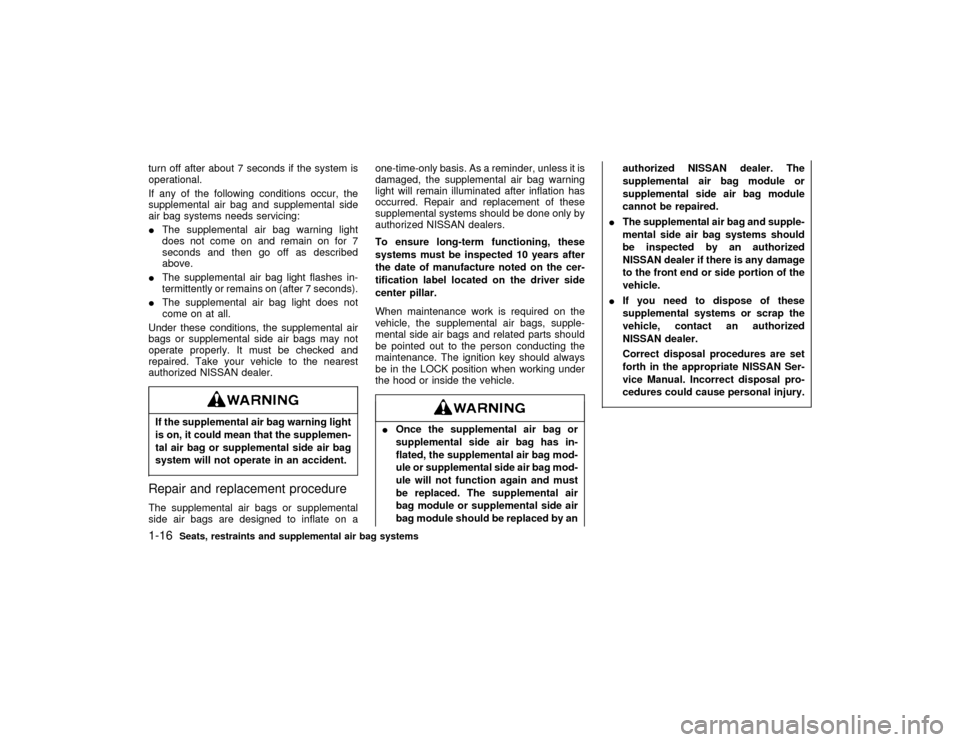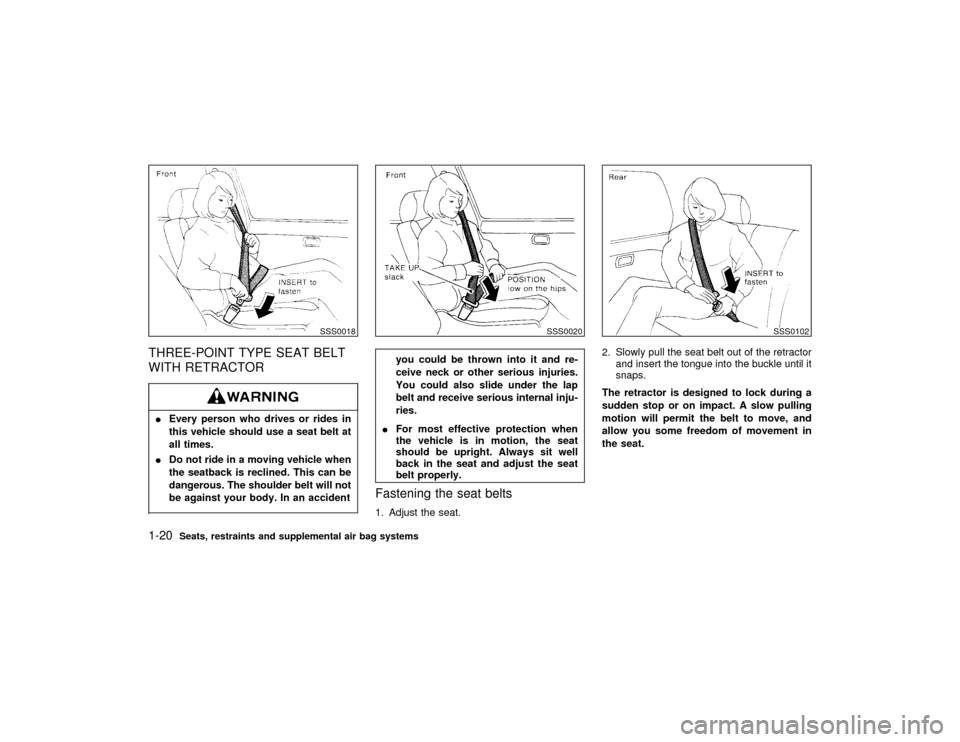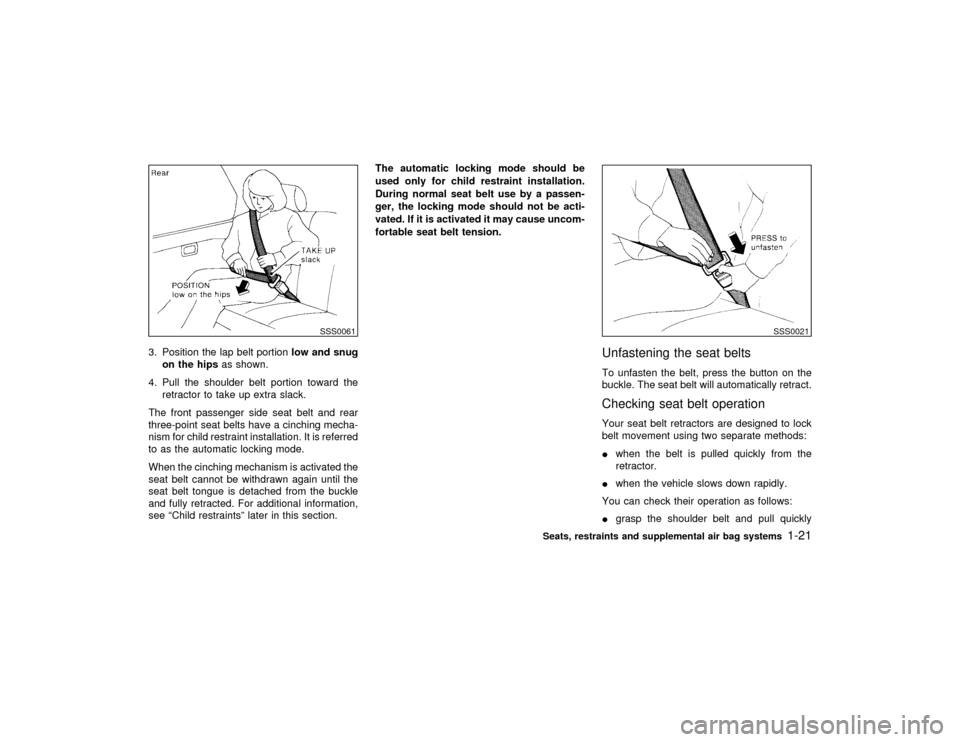Page 9 of 231
IDo not ride in a moving vehicle when
the seatback is reclined. This can be
dangerous. The shoulder belt will not
be against your body. In an accident
you could be thrown into it and re-
ceive neck or other serious injuries.
You could also slide under the lap
belt and receive serious internal
injuries.
IFor most effective protection when
the vehicle is in motion, the seat
should be upright. Always sit well
back in the seat and adjust the seat
belt properly. See ªPrecautions on
seat belt usageº later in this section.
FRONT MANUAL SEAT
ADJUSTMENTIDo not adjust the driver's seat while
driving. The seat may move suddenly
and could cause loss of control of the
vehicle.
IAfter adjustment, gently rock in the
seat to make sure it is securely
locked.
SSS0095
SEATS1-2
Seats, restraints and supplemental air bag systems
Z
01.1.31/A32-D
X
Page 10 of 231
Forward and backwardPull the lever up while you slide the seat
forward or backward to the desired position.
Release the lever to lock the seat in position.
RecliningTo recline the seatback, pull the lever up and
lean back. To bring the seatback forward
again, pull the lever and move your body
forward. The seatback moves forward.
Seat lifter (Driver's seat)Turn either dial to adjust the angle and height
of the seat cushion to the desired position.
SPA0097
SPA0099
Seats, restraints and supplemental air bag systems
1-3
Z
01.1.31/A32-D
X
Page 12 of 231
Seat lifter (Driver's seat)Push the front or rear end of the switch up or
down to adjust the angle and height of the seat
cushion.
Lumbar support (Driver's seat)The lumbar support feature provides lower
back support to the driver. Move the lever up
or down to adjust the seat lumbar area.
HEAD RESTRAINT ADJUSTMENTTo raise the head restraint, simply pull it up. To
lower, push the lock knob and push the head
restraint down.
Adjust the head restraints so the top is level
with the tops of your ears.Head restraints should be adjusted
properly as they may provide significant
protection against injury in an accident.
Do not remove them. Check the adjust-
SPA0100
SPA0467
SPA0014
Seats, restraints and supplemental air bag systems
1-5
Z
01.1.31/A32-D
X
Page 23 of 231

turn off after about 7 seconds if the system is
operational.
If any of the following conditions occur, the
supplemental air bag and supplemental side
air bag systems needs servicing:
IThe supplemental air bag warning light
does not come on and remain on for 7
seconds and then go off as described
above.
IThe supplemental air bag light flashes in-
termittently or remains on (after 7 seconds).
IThe supplemental air bag light does not
come on at all.
Under these conditions, the supplemental air
bags or supplemental side air bags may not
operate properly. It must be checked and
repaired. Take your vehicle to the nearest
authorized NISSAN dealer.If the supplemental air bag warning light
is on, it could mean that the supplemen-
tal air bag or supplemental side air bag
system will not operate in an accident.Repair and replacement procedureThe supplemental air bags or supplemental
side air bags are designed to inflate on aone-time-only basis. As a reminder, unless it is
damaged, the supplemental air bag warning
light will remain illuminated after inflation has
occurred. Repair and replacement of these
supplemental systems should be done only by
authorized NISSAN dealers.
To ensure long-term functioning, these
systems must be inspected 10 years after
the date of manufacture noted on the cer-
tification label located on the driver side
center pillar.
When maintenance work is required on the
vehicle, the supplemental air bags, supple-
mental side air bags and related parts should
be pointed out to the person conducting the
maintenance. The ignition key should always
be in the LOCK position when working under
the hood or inside the vehicle.
IOnce the supplemental air bag or
supplemental side air bag has in-
flated, the supplemental air bag mod-
ule or supplemental side air bag mod-
ule will not function again and must
be replaced. The supplemental air
bag module or supplemental side air
bag module should be replaced by anauthorized NISSAN dealer. The
supplemental air bag module or
supplemental side air bag module
cannot be repaired.
IThe supplemental air bag and supple-
mental side air bag systems should
be inspected by an authorized
NISSAN dealer if there is any damage
to the front end or side portion of the
vehicle.
IIf you need to dispose of these
supplemental systems or scrap the
vehicle, contact an authorized
NISSAN dealer.
Correct disposal procedures are set
forth in the appropriate NISSAN Ser-
vice Manual. Incorrect disposal pro-
cedures could cause personal injury.
1-16
Seats, restraints and supplemental air bag systems
Z
01.1.31/A32-D
X
Page 27 of 231

THREE-POINT TYPE SEAT BELT
WITH RETRACTORIEvery person who drives or rides in
this vehicle should use a seat belt at
all times.
IDo not ride in a moving vehicle when
the seatback is reclined. This can be
dangerous. The shoulder belt will not
be against your body. In an accident
you could be thrown into it and re-
ceive neck or other serious injuries.
You could also slide under the lap
belt and receive serious internal inju-
ries.
IFor most effective protection when
the vehicle is in motion, the seat
should be upright. Always sit well
back in the seat and adjust the seat
belt properly.
Fastening the seat belts1. Adjust the seat.2. Slowly pull the seat belt out of the retractor
and insert the tongue into the buckle until it
snaps.
The retractor is designed to lock during a
sudden stop or on impact. A slow pulling
motion will permit the belt to move, and
allow you some freedom of movement in
the seat.
SSS0018
SSS0020
SSS0102
1-20
Seats, restraints and supplemental air bag systems
Z
01.1.31/A32-D
X
Page 28 of 231

3. Position the lap belt portionlow and snug
on the hipsas shown.
4. Pull the shoulder belt portion toward the
retractor to take up extra slack.
The front passenger side seat belt and rear
three-point seat belts have a cinching mecha-
nism for child restraint installation. It is referred
to as the automatic locking mode.
When the cinching mechanism is activated the
seat belt cannot be withdrawn again until the
seat belt tongue is detached from the buckle
and fully retracted. For additional information,
see ªChild restraintsº later in this section.The automatic locking mode should be
used only for child restraint installation.
During normal seat belt use by a passen-
ger, the locking mode should not be acti-
vated. If it is activated it may cause uncom-
fortable seat belt tension.
Unfastening the seat beltsTo unfasten the belt, press the button on the
buckle. The seat belt will automatically retract.Checking seat belt operationYour seat belt retractors are designed to lock
belt movement using two separate methods:
Iwhen the belt is pulled quickly from the
retractor.
Iwhen the vehicle slows down rapidly.
You can check their operation as follows:
Igrasp the shoulder belt and pull quickly
SSS0061
SSS0021
Seats, restraints and supplemental air bag systems
1-21
Z
01.1.31/A32-D
X
Page 29 of 231

forward. The retractor should lock and re-
strict further belt movement.
If the retractor does not lock during this check
or if you have any questions about belt opera-
tion, see your NISSAN dealer.
Shoulder belt height adjustment
(For front seats)The shoulder belt anchor height should be
adjusted to the position best for you. (See
ªPrecautions on seat belt usageº earlier in this
section.) To adjust, squeeze the release but-
tons, and then move the shoulder belt anchor
to the desired position, so that the belt passes
over the center of the shoulder. The belt
should be away from your face and neck, but
not falling off of your shoulder. Release the
adjustment buttons to lock the shoulder belt
anchor into position.
IAfter adjustment, release the buttons
and try to move the shoulder belt
anchor up and down to make sure it
is securely fixed in position.
IThe shoulder belt anchor height
should be adjusted to the position
best for you. Failure to do so may
reduce the effectiveness of the entire
restraint system and increase the
chance or severity of injury in an
accident.
PD1321-A
1-22
Seats, restraints and supplemental air bag systems
Z
01.1.31/A32-D
X
Page 37 of 231
INSTALLATION ON REAR SEAT
OUTBOARD POSITIONSIThe three-point belt on your vehicle is
equipped with a locking mode retrac-
tor which must be used when install-
ing a child restraint.
IFailure to do so will result in the child
restraint not being properly secured.
It could tip over or otherwise be un-
secured and cause injury to the child
in a sudden stop or collision.
Front facingWhen you install a child restraint in a rear
outboard seat, follow these steps:
1. Position the child restraint on the seat. It
can be placed in a front facing direction,
depending on the size of the child. Always
follow the restraint manufacturer's instruc-
tions.2. Route the seat belt tongue through the child
restraint and insert it into the buckle until
you hear and feel the latch engage.
Be sure to follow the child restraint manu-
facturer's instructions for belt routing.
SSS0041
SSS0043
1-30
Seats, restraints and supplemental air bag systems
Z
01.1.31/A32-D
X